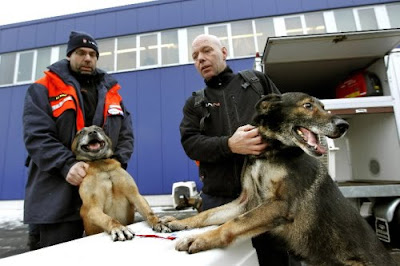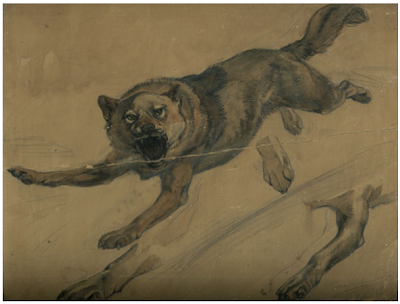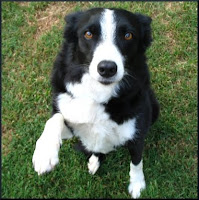 This is not herding. This is not herding. THIS IS NOT HERDING. Photo by Brandon Thibodeaux for The New York Times.
This is not herding. This is not herding. THIS IS NOT HERDING. Photo by Brandon Thibodeaux for The New York Times.It's prey drive. Say it with me: PREY DRIVE. Your dog is not herding.
But he's a "herding breed," you say?
Stop. Please.
Prey drive is what makes your dog nip at your elbow when you start running, if he doesn't know any better.
Also: there is no excuse for his not knowing better.
Ever notice how actual working-bred border collies — reactive dogs with the prey drive of a dozen hungry leopards — manage to run around an agility course without chasing and nipping at their handlers? Ever been to an actual sheepdog trial, and noticed how real stockdogs never "herd" spectators or stray children? That's because chasing people and nipping at them isn't herding.
So when I see something like this, I could beat my head on rocks. Dear jogger: your handsome Catahoula is not mouthing your elbow because he's a "herding breed." He's mouthing your elbow because he has no manners. Don't make excuses for his rude behavior. If you spend a little time training him, you'll both enjoy those jogging sessions a lot more.
[Have I made a distinction between prey drive and "herding" before? Why yes, in the very first post on this blog! I started this entire blogging endeavor just to rant about how much it grates to hear someone who has never worked livestock with a stockdog announce that Scout is "herding the kids" because Scout is a Sheltie and not a Cocker Spaniel and Shelties are "herding dogs" and oh please God make it stop before my head asplodes. Here is a reprint of that first post.]
**************
I know a number of keen, athletic dogs that love to crouch, stalk and circle. In fact, if they were border collies you’d say that they were stylish workers, with a fair amount of eye and good balance on their “stock” — but they’re not border collies. They’re not even “herding” dogs. They’re pit bulls, and the behavior they’re displaying is prey drive.
I’ve been told that most animal behavior texts don’t discuss drives, and when they do, the terminology is ambiguous. The consensus seems to be that the term is antiquated, though dog trainers discuss drives all the time: play drive, fetch drive, food drive, defense drive, fight drive. [Check out Schutzhund Obedience: Training in Drive at Dogwise.com.] Animal behaviorist Roger Abrantes writes that it is important to “distinguish between instinct and drive,” though, and I’m happy to give it a shot.
Drive means one of several varieties of “compulsive energy,” such as aggression, sex or self-preservation. Instinct is the inherent capacity to perform a complete behavior sequence: in this case the gathering of stock over vast areas of land and the conscientious management of that stock, in great or small numbers, in relation to a shepherd who may be close at hand or out of sight and miles away. This particular behavior sequence and its variations are instinctive in that they cannot be taught, only enhanced through experience, much as the ability to swim is acquired by young otters and flight perfected by young hawks. Prey drive, to use Mark Derr's definition, is “aggression that expresses itself as boldness and assertiveness in seeking and capturing objects.”
In his book The Sheepdog, Its Work and Training Tim Longton writes of his border collie Nell, who was suckling two-week-old pups and had been left home on a busy day. The shepherd and his helpers were endeavoring to move an unruly mob of lambs:
“[Nell] heard us trying to drive this lot along a rough bank where felled woodland and a landslide added to the hazards. I could hear her crying to be let out; a few minutes later she appeared, having gained the window. Two young lambs dashed uphill. Nell set off after them. She was fighting a losing battle, as the lambs split, and as soon as she had one on its way the other galloped madly in the other direction. I did not command her but, appreciating the position, Nell pushed one lamb in front of her and nosed it right in among the rest of the lambs. Then she returned for the other, which by now had escaped into a 200-acre field with 400 sheep in it. We continued our slow journey, and when we reached the far end there was Nell with a lamb pinned at the back of a gate. It was the lamb we wanted.”
That’s herding instinct. (Nell was English Shepherd’s Champion in 1951.) "It cannot be stressed too strongly," writes Longton, "that if you want a work dog both parents should be work dogs." Border collies bred to a working standard — that is, bred solely to work livestock — are the finest stockdogs on earth.
But when your sheltie, Belgian shepherd, beagle or Jack Russell runs happy, yappy laps around the neighbor’s grandkids, chases water from the garden hose until he’s soaked, nips at the hands and heels of your squealing six-year-old, runs furiously after every car, cat and bicycle he sees, or shows what passes for balance on dog-broke sheep in a round pen, that’s not herding instinct — it’s prey drive.
Prey drive is evident to some degree in most healthy dogs. Chihuahuas can exhibit prey drive. Poodles can display it. The only difference between their behavior and your neighbor’s sheltie’s behavior is that when poodles and chihuahuas get excited and chase children and nip fingers and heels, no one smiles and says, “Look! Bit-Bit is herding!"
The great majority of dogs in the American Kennel Club’s ironically named Herding Group would ignore livestock completely if it weren’t for prey drive. With sufficient prey drive, though, a responsive dog of practically any breed could win an AKC herding title. I’ve seen a determined pair of Lhasa apsos compete successfully in an arena trial, and years ago Diane Jessup’s pit bull Dread won high score on ducks at an ASCA [Australian Shepherd Club of America] competition — he pushed the ducks around the course with his nose. Not real herding, Ms. Jessup has said, just a good dog obliging his handler. (Dread was also titled on sheep.)
The American Kennel Club has always limited its herding contests to dogs in the AKC Herding Group: a face-saving conceit that perpetuates the myth of “herding breeds” with unique talents beyond the ken of pit bulls and Lhasa apsos. Perhaps this really was the case one hundred fifty years ago — before the onset of dog shows and breeding to a conformation standard — but with one or two notable exceptions, today’s “herding breeds" no longer have any working instincts that set them apart from Labrador retrievers or Dalmatians. In fact, during a major show circuit a few years ago, the most impressive “herding” dog at the popular “herding instinct test” was a friend’s golden retriever.
Herding, of course, has its evolutionary roots in prey drive. But prey drive itself — chasing, circling, crouching, stalking — is no reflection of herding background, instinct, ability, or potential. If it were, I’d be running my pit bulls in the USBCHA Finals.
I love dogs with high prey drive; they are easy to motivate and a joy to train. But when prey drive is dismissed, excused or poorly managed, it can place children and others at risk of a dog bite or attack. Ask my neighbor: Art spent time in the hospital after he was chased and pulled from his bike by a German shorthaired pointer. Dogs with high prey drive need appropriate exercise, good training and careful management — recommendations that apply to all dogs, but particularly to the ones that are more than two degrees north of stuffed.
When someone with a conformation-bred dog says, “Oh, look — Scout is herding the kids!” the truth is that Scout is only doing what any energetic dachshund, golden retriever or cocker spaniel would do under the same circumstances. It’s prey drive. It isn’t by any means unique to the so-called “herding breeds,” and it certainly isn’t “herding.”
*************
Related posts:
How to create a working stockdog
Great read: The Dog Wars by Donald McCaig
On titles and codes of ethics [or, "How can you tell if a dog is worth breeding if he doesn't have a title?" Answer: Watch him work.]
Zamora Hills [and some dog show]
The soft bigotry of low expectations suits the BCSA just fine
Inside animal minds

























